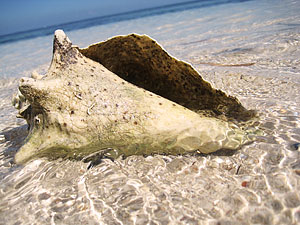Listen! You can hear the sounds of the ocean, but is it getting quieter?
 Last week while snorkeling in Roatan, Hondoruas, I came face to face with a Conch. Not a shiny shell in a gift shop, but a moving creature, shuffling along the sea floor, munching on grasses and just being a mollusk. I was in awe. My crew was still digesting the Conch Soup from the previous night and would soon tap our feet to a Garifuna performance complete with Conch Shell blowing. And haven't we all picked one up off of someone’s coffee table and listened to sounds of the ocean? I am sure I am not the only one who associates the Conch Shell, and so many shells, with jewelry, lamps, ash trays, picture frames, instruments, Bo Derek, and at times, dinner. But this, this was a living creature, using the shell for what it was created for; a home.
Last week while snorkeling in Roatan, Hondoruas, I came face to face with a Conch. Not a shiny shell in a gift shop, but a moving creature, shuffling along the sea floor, munching on grasses and just being a mollusk. I was in awe. My crew was still digesting the Conch Soup from the previous night and would soon tap our feet to a Garifuna performance complete with Conch Shell blowing. And haven't we all picked one up off of someone’s coffee table and listened to sounds of the ocean? I am sure I am not the only one who associates the Conch Shell, and so many shells, with jewelry, lamps, ash trays, picture frames, instruments, Bo Derek, and at times, dinner. But this, this was a living creature, using the shell for what it was created for; a home.
The study of shells, both amateur and professional, is called Conchology. There are millions of Conchology practitioners, or collectors, who feel drawn to collect shells. They are inspired by their spirals, blown away by their beauty, and drawn to keep them in their desire to connect with the earth. Many study shells scientifically and their findings can lead to conservation awareness, medical advances and my favorite, biomimicry ideas. I do not aim to deny anyone these experiences, but do wish to know how to collect shells, and all items from nature, responsibly.
As a conservation teacher, I have often talked to kids about picking flowers, etc. At times I will teach the ditty, "One for the butterflies, one for the bees, one for the beetles and one for me," honoring the deep need to be close to nature, while teaching that other creatures need these treasures for survival. Therefore, we share.
Tips for collection shells might be:
- Adhere to the environmental regulations of the state and country you are in (for California, go to www.dfg.ca.gov/fish/fishing)
- Put things back where you found them as you look
- Take only shells with nobody home
- Be aware of your source and their conservation practices before you buy
- Join a club that practices responsible collection
Other ideas would be appreciated.
